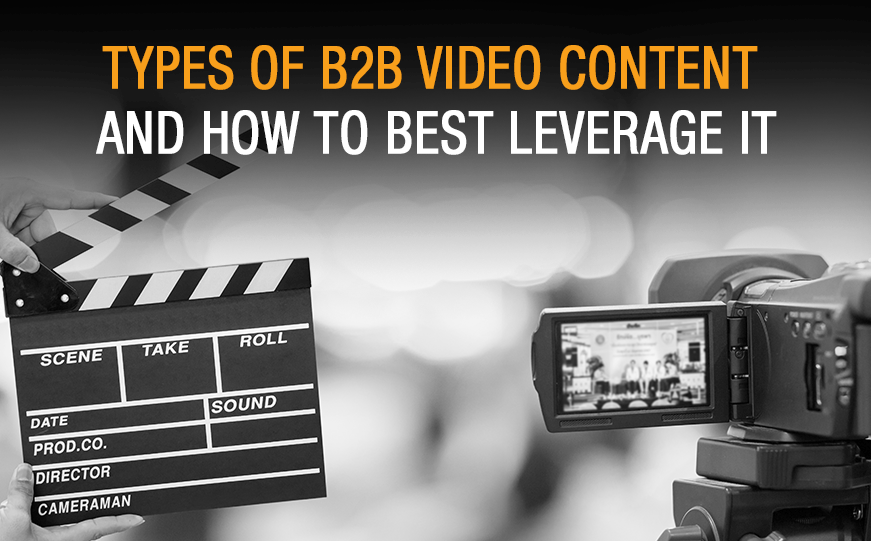These days, anyone with a smartphone can make and post a video. But useful video content that drives traffic and engages leads… involves more than a convenient device.
When approaching a particular campaign, often these are the qualifying questions:
- What kind of video will work best?
- What’s the focus of the video?
- What’s the ideal length?
- Where’s the best place to start?
It can be helpful to consider B2B videos as essentially being four specific types. Each has a unique style — and specific platform — where the content will be most effective.
Testimonials
Explainer and “how-to” videos help to communicate the features and benefits of a building product or service. All important advantages. Yet, prospective buyers will be looking for validation and proof.
Testimonials offer a dynamic way to showcase a brand promise… and reinforce trust. Prospects will be much more motivated to engage with a particular brand when they recognize that others in the channel have had positive and particularly relevant industry experiences with the brand’s products.
Explainers
B2B content must provide true value to resonate with an audience. Otherwise — let’s face it — it will be perceived as merely “shameless” self-promotion.
Explainer videos offer a compelling platform to share a concept that is highly technical. Or difficult to understand.
An explainer video can cut through these challenges… and provide viewers with a clear explanation of a brand’s unique solutions. By design, they answer an audience’s questions in advance. So that customers and prospects don’t have to go searching for answers elsewhere.
How-to Videos
Videos that demonstrate step-by-step instructions for a specific product or service are often called “how to” style. They can be particularly effective for building product brands that satisfy complex challenges.
When framing a how-to video, assume that an audience knows very little before viewing this type of content. And, in turn, invest the time to “over explain.” Provide the most value — by demonstrating the steps required — and present those instructions, in structured and sequential order.
Trending Topics
Creating a video about an industry-trending topic is an opportunity for a building product brand to stay highly relevant. And appeal to prospects who are seeking current guidance or a new direction. Trending topic videos also help to establish subject matter “authority” and thought leadership.
The Top Three Destinations for Posting
Websites and Landing Pages
Websites, microsites and campaign-specific landing pages — arrived at via unique calls-to-action — are important targets for video content. Yet, building product brands often overlook this available opportunity. And instead, tend to focus on social media sharing platforms.
Why make that unforced error? Videos help website page views become that much more dynamic. After all, video content — like all content — works best when it’s leveraged for multiple uses.
Explainer videos work well on homepages.
How-to videos contribute to more engaging blog posts.
Customer testimonial videos can enliven case studies.
And trend videos build on product specification pages to create more relatable experiences.
YouTube
There’s no dispute that YouTube provides a wealth of exposure for video content. In fact, the platform boasts more than 1 billion monthly users worldwide. It’s a top choice for many business accounts. And provides access to some important analytical tools.
Creating a dedicated channel… allows a building product brand to showcase a wide range of opportunities. Even to present a continuing series. The user-friendliness — and sheer volume of traffic — are both compelling.
Being found on YouTube is nurturing to an audience. And, most importantly, it means something for “search” optimization. After all, YouTube videos are favored in Google’s organic search results over other video platforms — like Vimeo and Dailymotion.
Other Social Media Platforms
B2B brands must elevate video exposure in 2023 for more robust social media engagement.
According to a report from Cisco, video makes up 82 percent of all web traffic… with social media hosting most of it.
For building product brands, the most important professional social platform continues to be LinkedIn. Instagram, TikTok, Facebook all have their place for design ideas and inspiration. But will only resonate when buyers and prospects leverage those platforms.
That’s a Wrap
Few other forms of media challenge video’s effectiveness. In fact, one study found that video can increase purchase intent by 82 percent.
What’s more, 73 percent of consumers claim they’re more likely to make a purchase after watching a branded video about a product or service. In 2022, 87 percent of the marketers in a large study said video had helped them increase web traffic… a significant increase from the 55 percent who said video boosted traffic in 2015.
Video content grabs attention.
It drives traffic.
And increases “buyer intent.”
Video campaigns are integral for a strategic B2B content mission. They help audiences cut through the noise — to better understand a value proposition — helping them gain trust and find answers to complex questions.
For a great example of how video story telling can help customers see a brand in a new light, follow this link to our “Campaign Critique” about an initiative from The Home Depot that seeks to accomplish just that. And if you’re ready to leverage video marketing to build awareness, establish thought leadership and live up to your brand promise reach out to sk@kleberandassociates.com and let’s get the conversation started.




